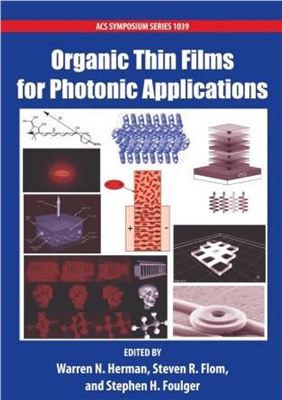Oxford University Press, 2010 - 302 pages
Organics are an extraordinarily large class of materials with promising applications for photonics and electronics. Today, organic light emitting diodes for optical displays and polymer waveguides discussed in several of the early OTF meetings have been developed to the point of highly successful commercialization. The development of organic nonlinear optical and optoelectronic materials for optical communications, power generation, data storage, and other applications have not yet reached the same level of maturity but offer the similar levels of promise that the early OLED and polymer waveguides studies showed. Organic Thin Films for Photonic Applications describes recent research in materials development, characterization techniques, and device development related to organic thin films for photonic applications.
The chapters of this book arose from a symposium that took place in Philadelphia at the annual ACS meeting in August 2008. They describe research progress in the development of materials, characterization techniques, and devices related to organic thin films for photonic applications. The topics covered can be divided into two general categories: the first involves organic nonlinear optics and the second involves organic semiconductors with emphasis on organic optoelectronics. Included are the development of chromophores with recording-setting electro-optic coefficients and poling of thick polymer slabs, demonstration of plasmonic waveguides in electro-optic materials, fabrication of the largest photorefractive 3D display to date, new photosensitive polymeric systems for optical data storage, 3D photonic structures fabricated by multiphoton absorption polymerization, a practical technique for measuring the phase of the complex third-order nonlinear susceptibility without the need for a reference material, electroluminescent colloidal particles that can be designed to produce a wide range of emission colors, the creation of thin-film lasers through the coextrusion of multilayered polymeric films, issues related to improving the power conversion efficiency of organic solar cells, various organic semiconductor materials and the use of terahertz spectroscopy techniques for determining carrier dynamics in organic semiconductors. In this introduction we provide some background information and a brief summary of the exciting developments reported in the remainder of the book.
Organics are an extraordinarily large class of materials with promising applications for photonics and electronics. Today, organic light emitting diodes for optical displays and polymer waveguides discussed in several of the early OTF meetings have been developed to the point of highly successful commercialization. The development of organic nonlinear optical and optoelectronic materials for optical communications, power generation, data storage, and other applications have not yet reached the same level of maturity but offer the similar levels of promise that the early OLED and polymer waveguides studies showed. Organic Thin Films for Photonic Applications describes recent research in materials development, characterization techniques, and device development related to organic thin films for photonic applications.
The chapters of this book arose from a symposium that took place in Philadelphia at the annual ACS meeting in August 2008. They describe research progress in the development of materials, characterization techniques, and devices related to organic thin films for photonic applications. The topics covered can be divided into two general categories: the first involves organic nonlinear optics and the second involves organic semiconductors with emphasis on organic optoelectronics. Included are the development of chromophores with recording-setting electro-optic coefficients and poling of thick polymer slabs, demonstration of plasmonic waveguides in electro-optic materials, fabrication of the largest photorefractive 3D display to date, new photosensitive polymeric systems for optical data storage, 3D photonic structures fabricated by multiphoton absorption polymerization, a practical technique for measuring the phase of the complex third-order nonlinear susceptibility without the need for a reference material, electroluminescent colloidal particles that can be designed to produce a wide range of emission colors, the creation of thin-film lasers through the coextrusion of multilayered polymeric films, issues related to improving the power conversion efficiency of organic solar cells, various organic semiconductor materials and the use of terahertz spectroscopy techniques for determining carrier dynamics in organic semiconductors. In this introduction we provide some background information and a brief summary of the exciting developments reported in the remainder of the book.

